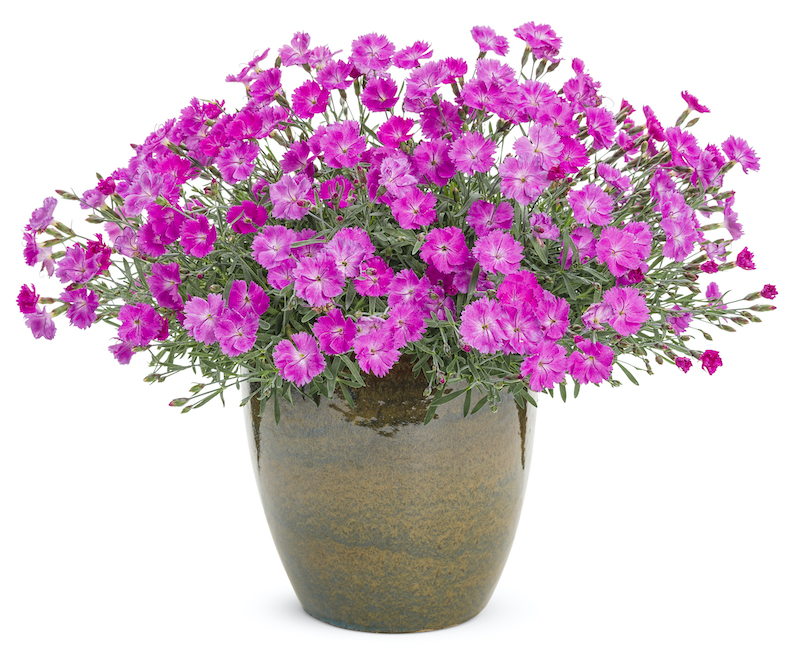Pretty Dianthus or “Pinks” as they are often called are perfect for planting in containers and window boxes. They can be grown alone or mixed with other plants for a cottage garden feel. They also have a sweet spicy scent, making a nice addition to seating areas, window boxes and entryways. They love to spread and can easily fill a container during a growing season, so keep that in mind when spacing with other plants. They can be added to larger hanging basket arrangements as the center element or focus plant.

Planting Dianthus in Pots
Dianthus works well as a container plant and can be planted in the spring and summer for a touch of romantic texture and color. They like a partial shade spot, which means three to six hours of sunlight each day. They do not do well in direct, hot sun locations. They also need sufficient drainage. Make sure your container has extra drainage holes. Dianthus does not like its roots to sit in water. The best material for planters is a porous one that can breathe and will not become waterlogged.
Best Soil For Dianthus in Pots
Choose a rich potting mix that is a little on the alkaline side. You can also add some slow-release fertilizer to the soil and mix well. You want to make it as easy as possible for your young plants to grow and thrive. You can add a thin layer of mulch to the top of your container to help with moisture retention. But be sure your plants are not smothered.
Caring For Dianthus in Planters
Dianthus are easy to care for in planters. Keep the soil moist with daily or every other day watering, and fertilize every 4 to 6 weeks with a good slow-release fertilizer. Deadheading your plants will also keep them growing and healthy. In hanging baskets, you may need to pull up and divide your dianthus if it is taking over other plants and running out of growing room.

Watering Dianthus in Pots
Dianthus does not like to be “too wet” but they do need to be watered regularly. A consistent watering schedule will benefit your plants the most. Make sure that the soil remains moist but not soggy or boggy. If your soil feels soggy, it is best to cut back on the amount of water. During times of rain you may not need to water your outdoor containers at all.
Fertilizing Dianthus in Pots
You may need to fertilize or feed your plants in containers more often than those that are planted in the ground. This is due to the fact that your container is a closed environment and has a limited quantity of nutrients. A regular monthly feeding schedule after the initial planting should work for most containers, which will keep your dianthus thriving and blooming.
Winter Care For Dianthus in Pots
Many dianthus varieties are hardy perennials and can be grown outdoors all-year round. At the lower end of its growing zone, you may want to give your containers some extra protection and move them to a warmer location when temperatures drop in the winter. You can move them next to the house or inside a greenhouse for the winter months.
You may also want to take the opportunity to dig up and divide your plants and repot them for the next growing season. Your dianthus plants will still need the basics of food, light and water. If you are storing them inside the garage or basement make sure they are not in total darkness. Use a grow light or place next to a south-facing window over winter.
Growing Dianthus Indoors
Dianthus is a garden plant and does not really make a good houseplant. For short periods of time, you can bring your potted plants inside to enjoy, but they will be much happier outdoors. Dianthus need plenty of bright sunshine, which is difficult to provide indoors. If you do wish to enjoy them inside, place them in a sunny window and water them each week to keep the soil evenly moist.
 |
Author Janice Cox - Published 06-30-2022 |
